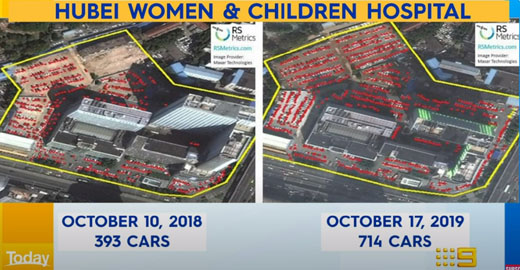by WorldTribune Staff, June 10, 2020
Harvard University researchers reported that trends in hospital traffic and search engine data in the late summer and early fall of 2019 from the Chinese province of Hubei, in which Wuhan is the capital city, indicate the coronavirus could have been spreading through China as early as August, much earlier than the communist government admitted.

The emergence of COVID-19 was initially linked to Wuhan in late November to early December 2019.
The new study, from Harvard Medical School led by Dr John Brownstein, analyzed commercial satellite imagery, according to reports by Financial Times and ABC News.
His team ‘observed a dramatic increase in hospital traffic outside five major Wuhan hospitals beginning late summer and early fall 2019’.
Chinese Foreign Ministry spokeswoman Hua Chunying immediately sought to discredit the study’s findings. ‘I think it is ridiculous, incredibly ridiculous, to come up with this conclusion based on superficial observations such as traffic volume,’ she said at a press briefing.
Vehicle counts extracted from satellite imagery of hospital parking lots in Wuhan were used by the researchers to estimate trends in hospital occupancy and explore an association with reported illnesses linked to influenza.
They also used Baidu search trends to analyze the searches of disease related terms.
The researchers collected 111 satellite images of Wuhan from Jan. 9, 2018 to April 30, 2020. They found that, between 2018 and 2020, there was a general increasing trend of hospital occupancy as measured by the parking lot volume.
“Something was happening in October,”Brownstein, the chief innovation officer at Boston Children’s Hospital and director of the medical center’s Computational Epidemiology Lab told ABC. “Clearly, there was some level of social disruption taking place well before what was previously identified as the start of the novel coronavirus pandemic.”
A steep increase in numbers began in August 2019, which resulted in a peak in December 2019. Between September and October 2019, five of the six hospitals demonstrated their highest relative daily volume from the analyzed data series.
This coincided with increased Internet search queries for terms such as “diarrhea” and “cough,” the researchers said.
The researchers noted that the increased search for “diarrhea” is only detectable in late 2019, however “cough” illustrates yearly peaks that align with influenza season.
“In August, we identify a unique increase in searches for diarrhea which was neither seen in previous flu seasons or mirrored in the cough search data. While surprising, this finding lines up with the recent recognition that gastrointestinal (GI) symptoms are a unique feature of COVID-19 disease and may be the chief complaint of a significant proportion of presenting patients,” the researchers wrote.
Intelligence Brief __________ Replace The Media
